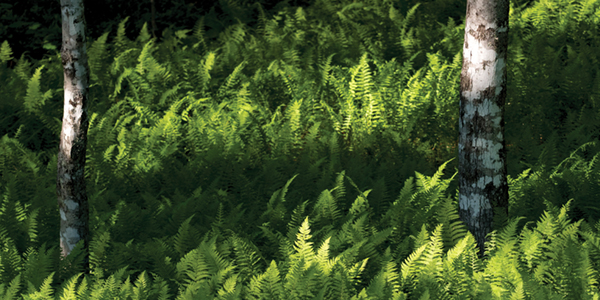The lesser known treasures of the St. Mary’s River
by Scott Leslie
Driving along the valley road I marvelled at the open groves of massive hardwoods growing in a sea of tall ferns located along the river. This green cathedral of temperate forest, with its large red oaks, yellow birch and red maples, forms a habitat that has become exceedingly rare throughout the continent: verdant river floodplain forest, undisturbed by significant development.
The first time I visited the Waternish dell of the St. Marys River was a revelation
Further up the road, I pulled over by the bridge that crosses the west branch of the St. Mary’s just before it enters the main branch a few hundred metres away. There, just south of the community of Glenelg, Guysborough County, I stood in the warm spring air, the river murmuring below
as a Canada warbler sang from nearby thicket, delivering its punchy, lilting song in the soft evening light. The peaceful, sublime nature of the area was quite unlike anything I had experienced before in the province. It was the perfect ending of a late spring day.
Nova Scotia’s longest river, running 250 kilometres through five eastern mainland counties, the St. Mary’s is probably best known as the most important salmon river on the mainland, as well as for its runs of gaspereau, shad, and smelt. Some 20 species of fish live throughout the river, lakes and ponds of the watershed, making it a piscine paradise. Less celebrated, however, is the St. Mary’s wonderful terrestrial biodiversity and the impressive forests living along its banks, not to mention a few stands of old eastern hemlock and spruce found in uplands of the 1,300 square kilometre watershed. Draining the waters of some 130 lakes, the river’s three branches (the East, West and North) enter at different points to ultimately culminate in the main branch of the St. Mary’s near Glenelg. From there it flows about 30 more kilometres to enter the Atlantic near the settlement of Sonora.
The impressive old-growth hardwood forest growing along the river serves a greater purpose than merely looking beautiful. It also provides critical habitat for wildlife that cannot survive in scrawny third growth woods or clearcuts. Unfortunately, there are far too many examples of deplorable forestry practices elsewhere in the five counties the St. Mary’s River drains.

Some 20 species of fish live throughout the river, lakes and ponds of the watershed, making it a piscine paradise
Threatened species, among them the olive-sided flycatcher, rusty blackbird, Canada Warbler and the wood turtle, live in the pristine habitat that still exists in places along the river, relying on an abundance of insects and other invertebrates that can only be sustained in a healthy ecosystem. Protecting the river’s forests also protects the riparian zone, the nexus of water and the adjacent lands. River embankments, streamside thickets, and periodically-flooding mature hardwood forest are parts of this crucial zone that provides a home for myriad species that live in this increasingly rare habitat type.

...this remarkable river’s wild inhabitants will survive well into the future
Fortunately, the need to protect the St. Mary’s River terrestrial ecosystem has not gone unnoticed, as successful efforts by St. Mary’s River Association, Nova Scotia Salmon Association and others to restore and enhance Atlantic Salmon habitat in the river itself have been ongoing for many years. In 2006, the Nova Scotia Nature Trust began its St. Mary’s River Conservation Legacy to: “protect the rare ecological gems of the river through land conservation... to create a ribbon of green—a corridor of intact riparian habitat along the river that will restore and ensure the ecological health of this very special place.”

protect the rare ecological gems of the river through land conservation... to create a ribbon of green...
Given the interconnections between land and water habitats, protecting floodplain forests along the river will not only help terrestrial species but will also contribute to a healthy aquatic environment by maintaining good water quality, temperature and depth in the adjacent river, including several important salmon pools and turtle habitats. The organization has protected nearly 400 hectares (and counting) of ecologically important land in nine properties of the watershed, giving us comfort that this remarkable river’s wild inhabitants will survive well into the future.
